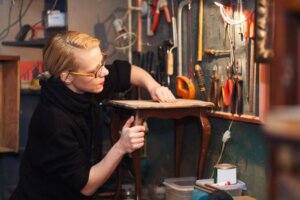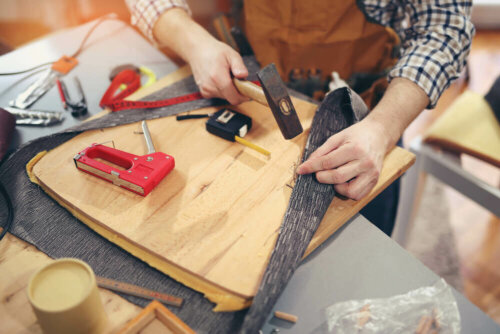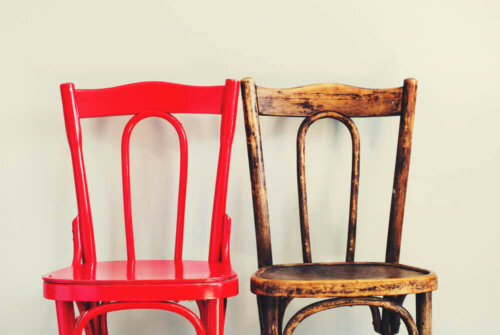Tips for Revitalizing and Restoring Furniture

These days, restoring furniture is no longer a task only for professionals. You can revitalize your furniture and save a lot of money if you follow these tips.
When we restore or recycle furniture, we also add value (in terms of sentimentality) because we did it ourselves. And, also, it can serve as good anti-stress therapy. In this article, we’ll give you some tips to make this task easier.
Tips for restoring furniture
You can start with something small and little by little teach yourself to do projects that involve more work.
The main challenge when it comes to recycling furniture is to see if the expectations match reality. For the end result to be as close as possible to what you have in your head, keep the following tips in mind.
1. The first tip for restoring furniture is to clean it well

This should be the first thing before starting any kind of work, craft, or DIY project. The surface we are going to work on must be free of all dirt, new or old.
Firstly, you can wipe it with a cloth moistened with water and neutral soap. Let it dry well. In case there are stains stuck on, you can use a brush or sponge dipped in solvent (ideal for painting).
You can even rub it with fine sandpaper in certain areas to make sure there are no traces of dirt or glued on items.
2. Repair

Some old furniture has holes due to use or the passage of time. However, if you want the restoration to be perfect, we recommend that you use a special product to fill them.
Follow the instructions and correct drying times so that the results are perfect, and if necessary, re-sand and clean before continuing with the recycling.
Wooden furniture is prone to scratches and nicks, marks that you can show off, or those you want to hide. If you want to cover them, we recommend special waxes to hide these imperfections.
3. The third step for restoring furniture is to pay attention to doors and furniture

If you want to restore furniture, it’s not a matter of modifying it only on an aesthetic level. You may have to repair vital pieces, such as doors, drawers, guides, hinges, etc.
Analyze the state of each part very carefully, open and close it, see how you can lighten or smooth the movements of the furniture. You may need nails, carpenter’s glue, screws, or an anticorrosive to oil metal parts.
Don’t forget, if necessary, check the locks and hardware of the piece. If they are bronze and worn, clean them with soap and water, and when drying, rub them with oil and a soft-bristled brush.
4. Renew upholstery

This task of restoring furniture has many aspects, and everything will depend on the type of object you want to recover. In the case of chairs or sofas, once you have analyzed and repaired the structure, the next step is to take care of the fabric.
This means taking whatever needs thorough cleaning to the dry cleaner, getting new cushions, or even upholstering it yourself. If the original fabric is no longer in good condition, look for one that goes well with the decoration of the surroundings.
5. Paint

When restoring furniture, the paint you use will be essential, since in most cases it’ll be what determines the final result. Use brushes of different thicknesses depending on the surfaces and use water-based paint. This is easier to remove if you don’t like how it looks.
As for colors or finishes, everything will depend on your taste, the decorative style of the room, or what you want to achieve. In any case, apply several thin coats instead of just one thick coat. And of course, let it dry well between layers.
Maybe you don’t want to go to the trouble of repainting the furniture. In that case, you can simply varnish or wax it. Believe it or not, it will give it a completely new life.
Before restoring furniture, we recommend you decide what style you want, how you would like it to look when the work is finished, how many tasks you’ll carry out, and who will take care of the others (for example, an upholsterer or a blacksmith).
These days, restoring furniture is no longer a task only for professionals. You can revitalize your furniture and save a lot of money if you follow these tips.
When we restore or recycle furniture, we also add value (in terms of sentimentality) because we did it ourselves. And, also, it can serve as good anti-stress therapy. In this article, we’ll give you some tips to make this task easier.
Tips for restoring furniture
You can start with something small and little by little teach yourself to do projects that involve more work.
The main challenge when it comes to recycling furniture is to see if the expectations match reality. For the end result to be as close as possible to what you have in your head, keep the following tips in mind.
1. The first tip for restoring furniture is to clean it well

This should be the first thing before starting any kind of work, craft, or DIY project. The surface we are going to work on must be free of all dirt, new or old.
Firstly, you can wipe it with a cloth moistened with water and neutral soap. Let it dry well. In case there are stains stuck on, you can use a brush or sponge dipped in solvent (ideal for painting).
You can even rub it with fine sandpaper in certain areas to make sure there are no traces of dirt or glued on items.
2. Repair

Some old furniture has holes due to use or the passage of time. However, if you want the restoration to be perfect, we recommend that you use a special product to fill them.
Follow the instructions and correct drying times so that the results are perfect, and if necessary, re-sand and clean before continuing with the recycling.
Wooden furniture is prone to scratches and nicks, marks that you can show off, or those you want to hide. If you want to cover them, we recommend special waxes to hide these imperfections.
3. The third step for restoring furniture is to pay attention to doors and furniture

If you want to restore furniture, it’s not a matter of modifying it only on an aesthetic level. You may have to repair vital pieces, such as doors, drawers, guides, hinges, etc.
Analyze the state of each part very carefully, open and close it, see how you can lighten or smooth the movements of the furniture. You may need nails, carpenter’s glue, screws, or an anticorrosive to oil metal parts.
Don’t forget, if necessary, check the locks and hardware of the piece. If they are bronze and worn, clean them with soap and water, and when drying, rub them with oil and a soft-bristled brush.
4. Renew upholstery

This task of restoring furniture has many aspects, and everything will depend on the type of object you want to recover. In the case of chairs or sofas, once you have analyzed and repaired the structure, the next step is to take care of the fabric.
This means taking whatever needs thorough cleaning to the dry cleaner, getting new cushions, or even upholstering it yourself. If the original fabric is no longer in good condition, look for one that goes well with the decoration of the surroundings.
5. Paint

When restoring furniture, the paint you use will be essential, since in most cases it’ll be what determines the final result. Use brushes of different thicknesses depending on the surfaces and use water-based paint. This is easier to remove if you don’t like how it looks.
As for colors or finishes, everything will depend on your taste, the decorative style of the room, or what you want to achieve. In any case, apply several thin coats instead of just one thick coat. And of course, let it dry well between layers.
Maybe you don’t want to go to the trouble of repainting the furniture. In that case, you can simply varnish or wax it. Believe it or not, it will give it a completely new life.
Before restoring furniture, we recommend you decide what style you want, how you would like it to look when the work is finished, how many tasks you’ll carry out, and who will take care of the others (for example, an upholsterer or a blacksmith).







